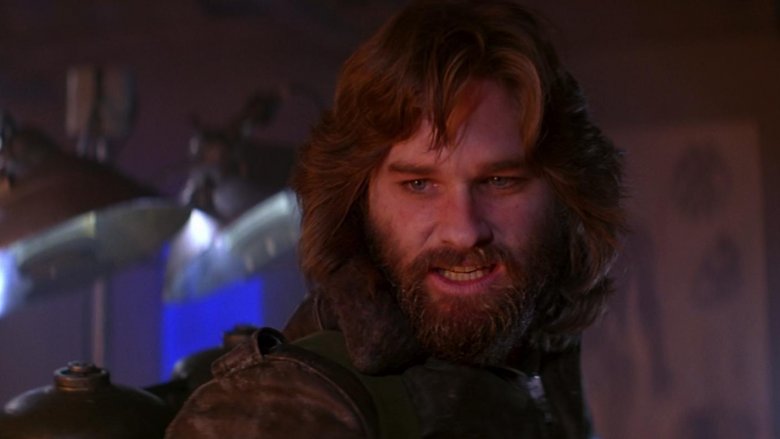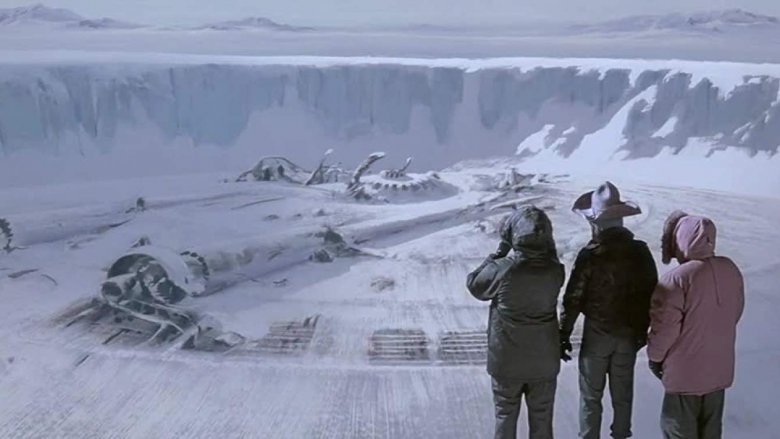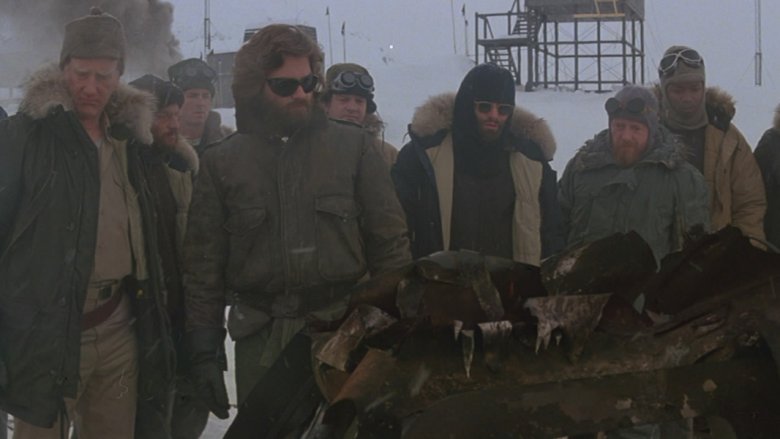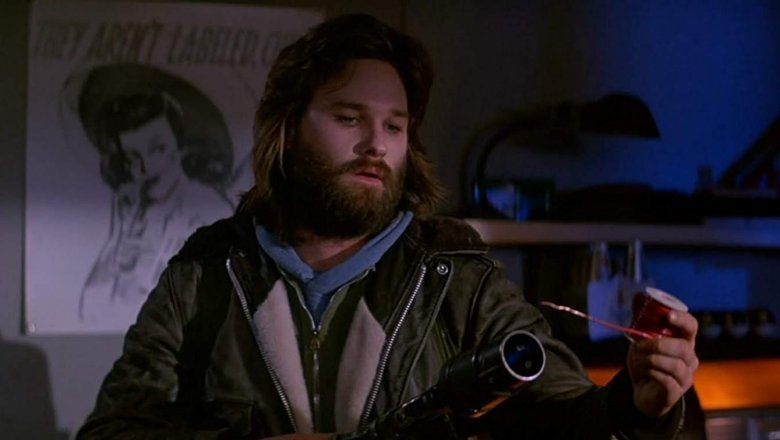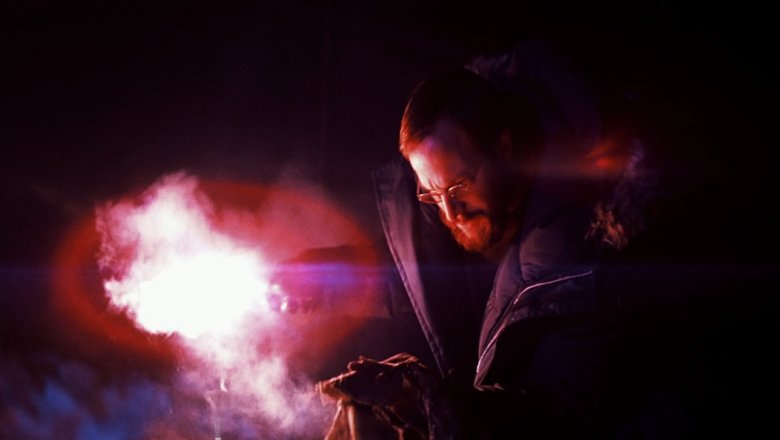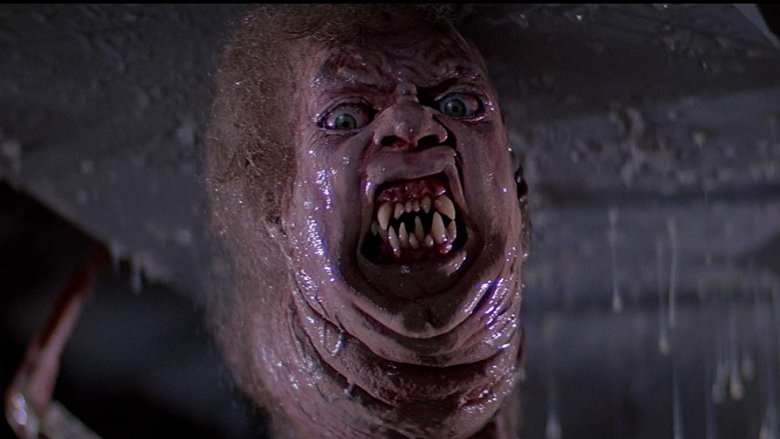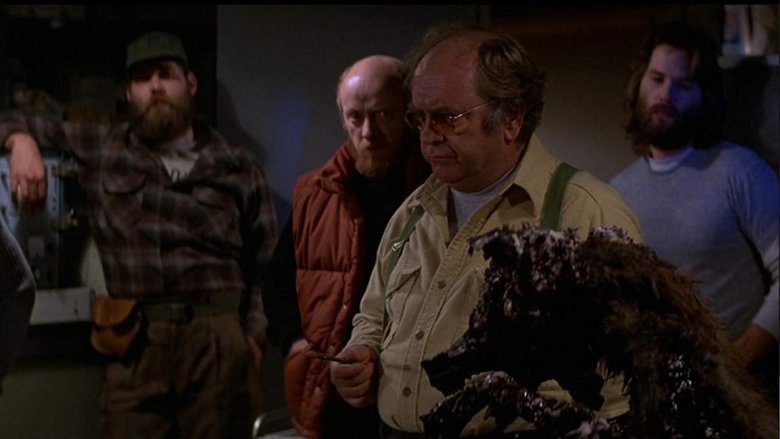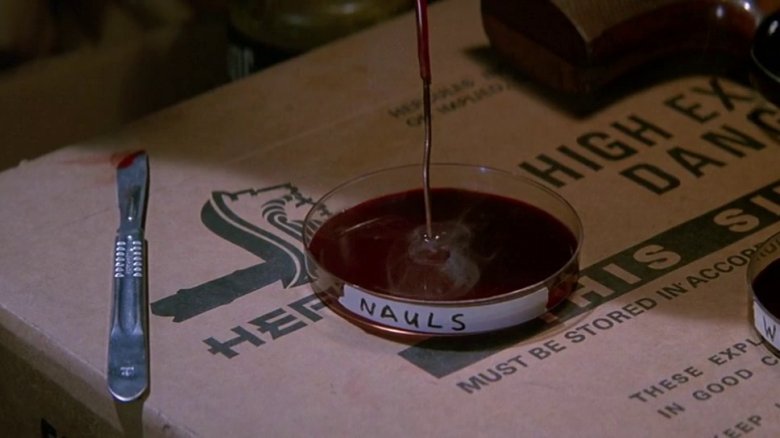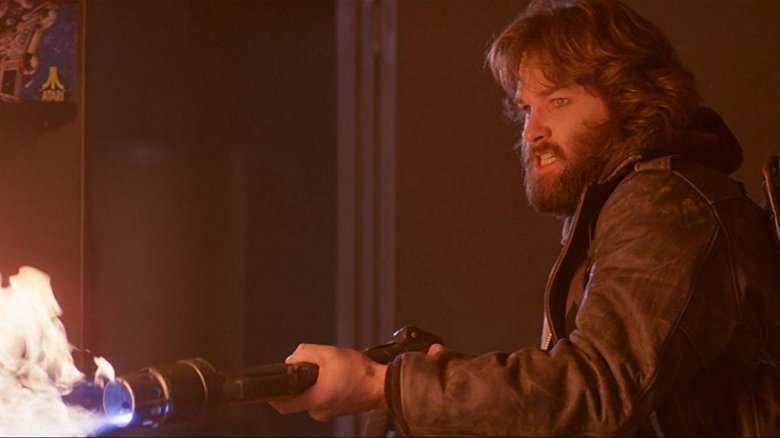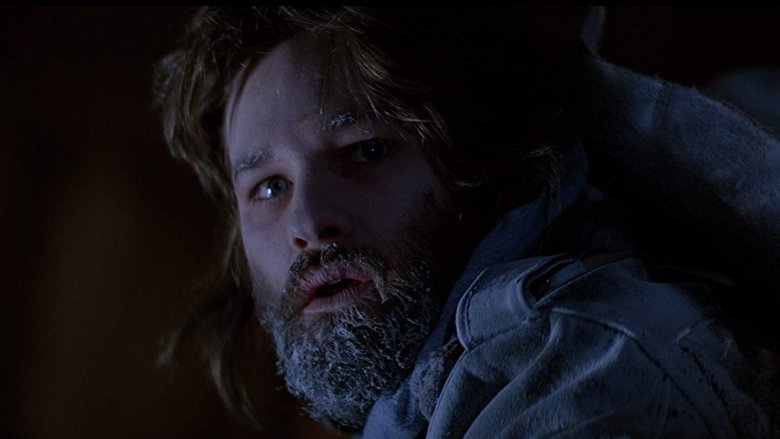The Ending Of The Thing Explained
It's been nearly four decades since its release, and John Carpenter's The Thing remains one of the most untouchably gruesome and great horror films of all time, beloved by fans of multiple generations and still celebrated by horror critics and filmmakers alike. Carpenter's film — the story of an arctic research station slowly brought to its knees by an unseen alien form — is a confluence of Carpenter's love of the classic film The Thing From Another World and his matured skills as a director after great work in the 1970s. Together with great makeup effects by Rob Bottin and a fantastic ensemble cast led by Kurt Russell, it all adds up to a compulsively watchable thrill ride.
As famous as it is for Russell's performance and Bottin's legendary creature designs, though, The Thing is also famous for its ending, which leaves plenty of unanswered questions and implications for viewers to pick over long after the credits have rolled. With that in mind, this is the ending of The Thing, explained.
Other ships, other threats
The film opens with the evocative image of a traditional flying saucer catapulting through space toward Earth. Later, we learn that the craft crashed on our planet, in what is now Antarctica, and according to Norris (Charles Hallahan) it has perhaps been buried in the ice for 100,000 years. That's virtually all we get of the Thing's origin story as it moves through the station, and like so much else in the film, it leaves plenty of unaddressed implications behind. That ship looked rather sophisticated, which suggests that an alien race of considerable technological acumen created it.
If that's the case, then it's very possible that even if that was the only ship, they ultimately built more, and if they built more, it's possible and even likely that other such ships made their way to Earth at some point or another. Have any of them crashed, or even landed? Is there a whole fleet out there, just waiting for a single sign that life on our planet is just a little safer? Or, was the ship's crash landing just a fluke that doesn't spell any further alien contact for us? It's impossible to tell, but the presence of that ship hangs over the whole movie.
Radio silence
Early in the film, after the Norwegian helicopter incident, Windows (Thomas Waites) gets on the radio and tries to report what's happened, but he can't get through to any other station. When Blair (Wilford Brimley) presses him on the matter, Windows confesses that he hasn't been able to get through to anyone else in two weeks, and speculates that no one on the continent is able to reach anyone else. Moments before that, MacReady (Kurt Russell) notes that it's the first week of winter.
What's going on? Are radio communications always so bad that weeks go by without anyone hearing from anyone else? It's possible, and it sets up the isolation in the film that ultimately leads to its rather dark ending, but it's also possible that something else is at work here. The Thing infiltrated the Norwegian station because they dug it up, but what if it somehow managed to infect other stations as well, either through other crafts or because its ability to divide itself means it can somehow travel? We simply don't know enough about how the creature works to completely rule such a thing out.
A persistent lifeform
The alien spacecraft that contained the Thing, even if it was in some kind of stasis, has been present on our planet for millennia. The movie gives us no sign that there's any more than one ship, but it also doesn't give us the entire history of the creature. That means it's entirely possible that this has happened before, either with another spacecraft or with the same spacecraft encountered by other people.
A lot has changed in 100,000 years. The craft wasn't necessarily always completely buried in the ice. What if there is alien DNA out in the world right now, because someone many centuries ago has already encountered it? Again, the film succeeds by leaving such questions unanswered, and by dialing up the paranoia over what the Thing is and does. It can infiltrate and assimilate seamlessly if it wants to, so who's to say it hasn't already?
Scraps of MacReady
As the paranoia over who might be infected by the Thing sets in, the men of the station begin to turn on each other. This starts to reach a fever pitch when Nauls (T.K. Carter) tries to leave MacReady out in the storm after finding his torn jacket outside, suggesting that he may have been attacked. MacReady eventually makes his way back and ultimately takes command of the survivors, conducting a blood test (one of the film's most famous sequences) just a little while later after he holds the others off with dynamite.
One thing that's particularly interesting about this plot point is how quickly it seems to be passed over by other events. MacReady, of course, forcefully asserts himself back into the group, but there's still the matter of that tattered jacket. Is there a logical reason for it to be there? Is it really proof that Mac was already assimilated and the organisms controlling him are just extremely good at hiding it, or is something else going on? The film leaves that question unanswered, but it feeds into the famous final scene in a major way.
More than one Thing
The most memorable gore effect in the entire film comes during the defibrillation sequence, when Copper (Richard Dysart) is attacked by the thing in the form of Norris, who had just seemingly suffered a heart attack during the confrontation with MacReady. As the group fights to incinerate the creature, it rips off Norris' head, which then pulls itself across the floor and sprouts legs and antenna. This means, according to MacReady, that the thing is not just one organism — it can divide itself, and each part has its own form of sentience. The head was trying to survive on its own when it knew the rest of Norris' body would be burned.
This, of course, raises a bigger question. We've seen a lot of infected bodies burned after encountering the Thing, but how do we know every piece of those bodies was burned? How do we know there's not still something crawling around the station, or even the Norwegian outpost, just waiting for its moment to graft onto another Earth life? For all we know, even the final explosion didn't kill every living thing left in the station.
Using Blair to build
The first sign of major, destructive paranoia among the men at the station comes when Blair begins to lose it, starts killing the dogs and destroying the vehicles and communications systems, for fear that they have to contain the Thing or risk it enveloping the entire planet. Blair is locked up and believed to simply be out of his mind, but it later becomes clear that he too has been infected. That means, among other things, that he's been using his time in isolation to construct a makeshift spacecraft, presumably so that the Thing can eventually leave the planet, perhaps to bring back more of its kind.
This shows that the Thing is adept not just at appearing human, but at using human skills to suit its own needs. It's not just mindlessly assimilating — it's making plans and constructing things to carry those plans out. What else could the creature (or creatures) ultimately build? Can it recreate alien technology out of human machinery? Could it adapt our own advances to its needs, and if so, how quickly? It's another of those unanswered questions that just makes the film more terrifying.
After the blood test
The blood test sequence, combined with the severed head sprouting legs, raises another interesting question about the nature of the Thing. Palmer (David Clennon) turns out to be the one whose blood is infected, and we see his blood basically jump out of its petri dish when confronted with the hot wire. We also know that the Thing will divide into different parts that will act independently if they need to, and that it can infect people on a micro level.
Does all of this combined mean that infected blood can in some way act, or at least survive, on its own? There's a lot of blood scattered throughout the film, both in the Norwegian station and among the Americans. If it's able to somehow retain the alien organism within it, it could at the very least survive in the cold, if only in stasis. If it's able to transfer itself to other tissue it comes in contact with, it could do even more than that. Fire destroys a lot, but it can't eliminate every drop of blood.
"See what happens"
The film's ending is famously ambiguous. After destroying the station, MacReady stumbles outside with a bottle of scotch in hand to find Childs (Keith David) returning, claiming he had left to look for Blair and subsequently disappeared during the final struggle. As they both eye each other with suspicion, MacReady suggests that they'll likely freeze to death anyway, so they should just wait around and "see what happens" in the meantime. This has led to a number of fan theories hypothesizing which of the two men might be infected. It could be either Mac or Childs, or maybe it's both.
Some fans claim Mac's bottle isn't filled with Scotch, but gasoline, and perhaps he tricked Childs into proving he isn't human by making him drink it. Some fans think that little smile at the end means Mac is the Thing. The closest thing to a definitive answer may have come from cinematographer Dean Cundey, who said he and Carpenter used eye light to show who was human and who wasn't. If that's true, and you look closely, it's more likely the thing is Childs than MacReady.
The Thing lives?
Whether it's MacReady or Childs, there is a strong implication at the end that at least one of the two men remains infected by the Thing and its alien powers, which suggests that the story is not over. So, what happens now? If only one of them is the Thing, it's quite likely it will eventually assimilate the other human body, and if that's true it's also possible they could survive longer than normal human bodies.
Could they hold out long enough to wait for help and pretend that they're just miraculous survivors? Could they feign death and assimilate other, healthier humans? Could they let the ice reclaim them and return to the same kind of stasis from which the Thing apparently came? These are all possibilities, but the overall point remains: this story is quite possibly not over, and the version of Earth on which this film takes place could very well be doomed.
